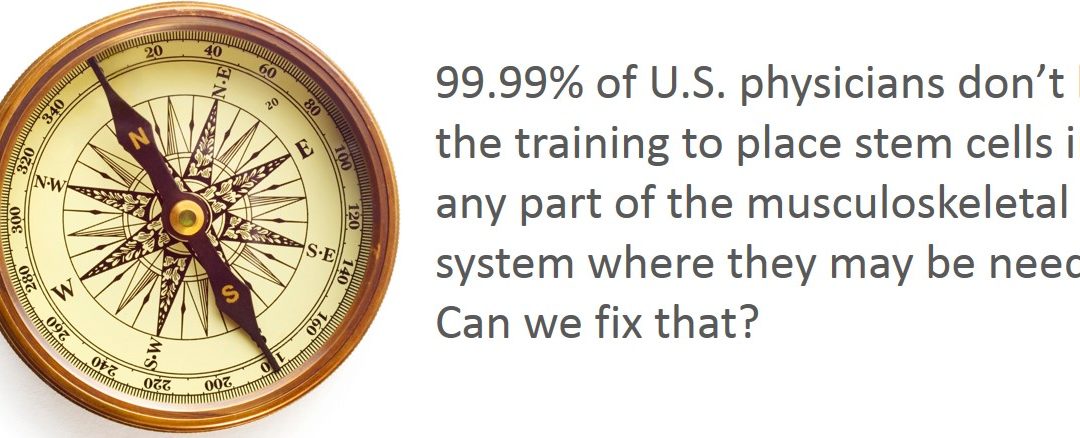Reflecting On Interventional Orthopedics and Our Fellowship
Last week, I spent a significant portion of the day working on the fifth generation of a device to accurately place stem cells into specific portions of the disc. This means working with a cadaver and testing the usability of the device against the actual human tissue. While that may seem morose, it’s how new devices get developed. More interesting was the additional advanced training we were able to accomplish with our fellow. During the day, I also spoke with our two former fellows and reflected on what interventional orthopedics is as a new medical specialty. It’s the ability to place a needle with high accuracy anywhere in the human musculoskeletal system (and perhaps more importantly to know why it should go there). Right now there are just a handful of physicians who can pass this test.
Let’s explore why this is the case. First, many doctors still inject joints, ligaments, and tendons blind. What does blind mean? It means the doctor doesn’t use imaging to guide the needle where it needs to go and has to guess that it’s in the right place. Is guessing in medicine a good idea? Nope. IMHO, in this day and age, performing most injections blind is below the standard of care. Since most physicians (especially surgeons) are still doing this, we can cross off our list about 70% of doctors.
Now let’s look at the remaining 30% of physicians who can perform an injection with guidance. The first big group to examine are physicians practicing pain management in the spine. There are perhaps 10,000 pain management physicians. About 2,000-3,000 of these are well trained and know their way around most of the spine. However, the spine has lots of places that might need treatment, so let’s reduce the group by only looking at those who can place a needle into all of the spine. Only the most advanced practitioners will have developed the skills to safely access the high neck, so only about 500 of our several thousand will have any experience placing needles into this area (C0-C2) and only about 20-40 of those will have injected these joints with any frequency. Now let’s look at skills outside the spine. Of this entire group (all 10,000), only about 1,000 routinely inject into what we call peripheral joints, say into a knee using real time x-ray (fluoroscopy). However, to really place cells with high accuracy into some joints and many ligaments/tendons/nerves you need to be experienced in ultrasound, as this technology images many of these structures better. Only about 300-400 of our group have any experience with ultrasound guidance, as interventional spine physicians prefer to use fluoroscopy. Only about 30-50 physicians in the U.S. are as comfortable using ultrasound to perform advanced ligament and tendon injections (say hitting the ACL under ultrasound) as they are performing advanced spine injections using fluoroscopy. So what I’m trying to get at, and what we mused about last week, is that there are only a handful of physicians in the U.S. that meet our criteria of being able to place stem cells into any part of the musculoskeletal system.
Think about that for a second. If you have ankle pain, a loose ligament in your knee, and headaches from a neck injury, the likelihood of finding a physician who can take care of all of those issues with advanced skills is less than finding a needle in a haystack. Your orthopedic surgeon isn’t trained to do this, regardless if he or she may know how to perform some spinal injections. Neither can 99.9% of the pain management physicians. How about the average physician who has completed a sports medicine fellowship-nope. An interventional radiologist? None that I have seen. Even if we could find one of these, the likelihood that they would have the musculoskeletal training to determine which areas should be treated brings us back to our needle in a haystack.
If you don’t have these problems, who cares? The promise of stem cells is that they can repair tissue, so mucking up the tissue with surgery to place stem cells (most of the time) will be a dumb idea. The smartest way to place these cells will be through a needle. If you’re an active person, you may need stem cells, platelets, or whatever regenerative agent is invented over the next 1-2 decades placed in the least invasive way possible in a specific part of the musculoskeletal system with whatever technology best fits the injection (sometimes fluoroscopy and sometimes ultrasound). Regrettably, right now, the likelihood that you would find that physician in any given medical practice in your town is slim and none. They just don’t exist yet. Hence the reason why we have a fellowship-to train young doctors how to place the latest and greatest biologics in any part of the body where they may be needed.
The upshot? If stem cells and other biologic agents are to reach their full potential in orthopedics, we need an army of physicians who know how to place these agents in the areas where they will do the most good in a way that will be least invasive. While in the future this will sometimes require surgery, for the most part, it will be through a needle or the needle like tools developed over the next two decades. The basic skill set needed will be immense and complex, but critical. So as we pour through another ever growing list of excellent candidates for our Regenexx Interventional Orthopedics Fellowship, we’re very cognizant that the the physicians leaving this year long training will be a hyper-elite group. The bad news is that teaching one or two doctors a year won’t begin to put a drop in the bucket of the army of physicians with interventional orthopedics skills that we need. Hence, we need another 10-20 programs like ours to crop up over the next few years. Any takers?
See original post here: http://www.regenexx.com/2014/09/reflecting-on-interventional-orthopedics-and-our-fellowship/

